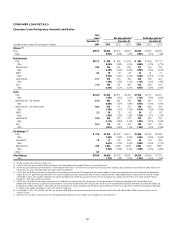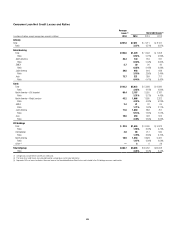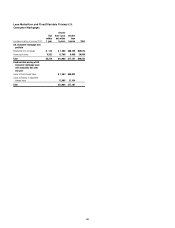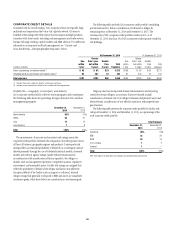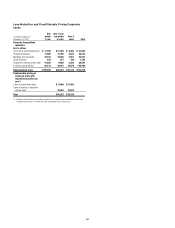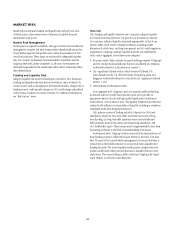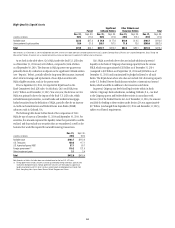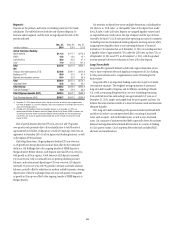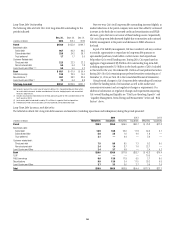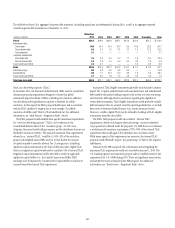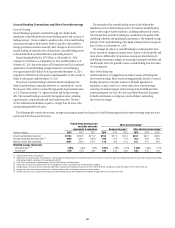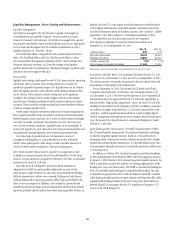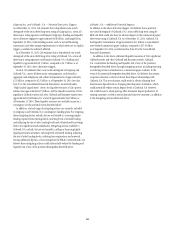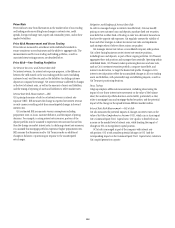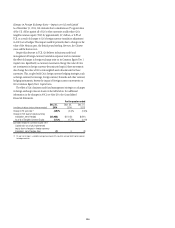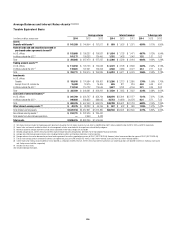Citibank 2014 Annual Report Download - page 114
Download and view the complete annual report
Please find page 114 of the 2014 Citibank annual report below. You can navigate through the pages in the report by either clicking on the pages listed below, or by using the keyword search tool below to find specific information within the annual report.
97
The table below shows Citi’s aggregate long-term debt maturities (including repurchases and redemptions) during 2014, as well as its aggregate expected
annual long-term debt maturities as of December 31, 2014:
In billions of dollars
Maturities
2014 2015 2016 2017 2018 2019 Thereafter Total
Parent $38.3 $16.6 $20.9 $26.1 $12.9 $20.0 $61.5 $ 158.0
Benchmark debt:
Senior debt 18.9 10.0 14.4 19.7 9.5 14.9 28.2 96.7
Subordinated debt 5.0 0.7 1.5 3.1 1.2 1.5 17.5 25.5
Trust preferred 2.1 — — — — — 1.7 1.7
Customer-related debt:
Structured debt 7.5 4.0 4.0 2.7 1.7 1.8 8.1 22.3
Non-structured debt 2.4 1.8 1.0 0.6 0.5 0.2 1.8 5.9
Local Country and Other 2.4 0.1 — — — 1.6 4.2 5.9
Bank $20.6 $14.5 $21.2 $14.2 $ 9.1 $ 2.1 $ 4.0 65.1
FHLB borrowings 8.0 3.8 9.2 6.3 0.5 — — 19.8
Securitizations 8.9 7.7 10.2 6.4 8.3 1.9 3.6 38.1
Local Country and Other 3.7 3.0 1.8 1.5 0.3 0.2 0.4 7.2
Total long-term debt $58.9 $31.1 $42.1 $40.3 $22.0 $22.1 $65.5 $ 223.1
Total Loss-Absorbing Capacity (TLAC)
In November 2014, the Financial Stability Board (FSB) issued a consultative
document proposing requirements designed to ensure that global
systemically important banks (GSIBs), including Citi, maintain sufficient
loss-absorbing and recapitalization capacity to facilitate an orderly
resolution. In this regard, the FSB’s proposal builds upon and is consistent
with the FDIC’s preferred “single point of entry strategy” for orderly
resolution of GSIBs under Title II of the Dodd-Frank Act (for additional
information, see “Risk Factors—Regulatory Risks” above).
The FSB’s proposal would establish firm-specific minimum requirements
for “total loss-absorbing capacity” (TLAC), set by reference to the
Consolidated Balance Sheet of the “resolution group” (in Citi’s case,
Citigroup, the parent bank holding company, and its subsidiaries that are not
themselves resolution entities). The proposed minimum TLAC requirement,
referred to as “external TLAC,” would be (i) 16%–20% of the resolution
group’s risk-weighted assets (RWA) and (ii) at least double the amount
of capital required to meet the relevant Tier 1 Leverage ratio. Qualifying
regulatory capital instruments in the form of debt plus other eligible TLAC
that is not regulatory capital would need to constitute 33% of external TLAC.
Regulatory capital instruments used by the GSIB to satisfy its applicable
regulatory capital buffers (i.e., the Capital Conservation Buffer, GSIB
surcharge and, if imposed, the Countercyclical Capital Buffer) could not be
counted toward the external TLAC requirement.
As proposed, TLAC-eligible instruments generally would include Common
Equity Tier 1 Capital, preferred stock and unsecured senior and subordinated
debt issued by the parent holding company with at least one year remaining
until maturity. Although there is uncertainty regarding the eligibility of
certain debt instruments, TLAC-eligible instruments would generally exclude
debt instruments that are secured, issued by operating subsidiaries, or include
derivatives or derivative-linked features (e.g., certain structured notes).
Moreover, a GSIB’s eligible TLAC may be reduced by holdings of TLAC-eligible
instruments issued by other GSIBs.
The FSB’s TLAC proposal would also establish “internal TLAC”
requirements, which would require that each foreign “material subsidiary”
(as proposed to be defined under the proposal) of a GSIB that is not otherwise
a resolution entity maintain a minimum of 75%–90% of the external TLAC
requirement that would apply if the subsidiary was a resolution entity.
While many aspects of this requirement are uncertain, the internal TLAC
proposal would effectually require “pre-positioning” of TLAC to the required
subsidiaries.
Pursuant to the FSB’s proposal, the conformance period regarding the
minimum TLAC requirements would not occur before January 1, 2019. The
U.S. banking agencies are expected to propose rules to establish similar TLAC
requirements for U.S. GSIBs during 2015. There are significant uncertainties
and interpretive issues arising from the FSB proposal. For additional
information, see “Risk Factors—Regulatory Risks” above.


